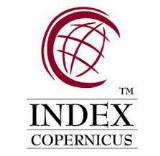
A time-dependent SIR model for COVID-19 in Azerbaijan
Research article: A time-dependent SIR model for COVID-19 in Azerbaijan
Authors: R.I. Khalilov1*, G.A. Aslanova2
1 Department of Biophysics and Biochemistry, Baku State University, 23 academician Z.Khalilov Str., Baku AZ1148, Azerbaijan
2 Department of Molecular Biology and Biotechnologies, Baku State University, 23 academician Z.Khalilov Str., Baku AZ1148, Azerbaijan
*For correspondence: hrovshan@hotmail.com
Received 03 Novembe 2020; Received in revised form 18 November 2020; Accepted 23 Novembe 2020
Abstract:
A novel coronavirus named ‘‘2019-nCoV’’, has been causing the deadliest pandemic in late 2019 and early 2020. This novel virus was defined as the coronavirus disease 2019 (COVID-19) by the World Health Organization (WHO). Diseases have afflicted humans ever since there have been human be- ings. From AD 541 to 542, the global pandemic known as “the Plague of Justinian” is one of the worst pandemics in the world and is estimated to have killed 15–25% of the world’s 200 million population. Today we are battling to control and prevent the spread of COVID-19. Coronavirus has the potential to cause the deadliest pandemic in human history. The number of cases of COVID-19 outside China has drastically grown up since 16th March, 2020. On 28 February, 2020 Azerbaijan has confirmed first positive case of COVID-19 within its border. The patient, a Russian national, had traveled from Iran to Azerbaijan. On 31 October, 2020 the total number of confirmed coronavirus cases is 55.269 in Azerbaijan. In this paper, we conduct mathematical and numerical analyses of COVID-19. We have applied the SIR model considering data from Azerbaijan. Assuming the published data are reliable, the SIR model can be applied to assess the spread of the COVID-19 disease and predict the number of infected, removed and recovered populations and deaths in the communities, accommo- dating at the same time possible surges in the number of susceptible individuals.
Keywords: COVID-19, SIR, mathematical model, simulation, susceptible, infected, recovered
References
Backer J., Klinkenberg D., Wallinga J. (2020)Incubation period of 2019 novel coronavirus (2019-nCov) infections among travellers from Wuhan, China, 20-28 January. Eurosurveillance, 25(5): Article ID 2000062, 6 p.
Chinazzi M., Davis J.T., Ajelli M., Gioannini C., Litvinova M., Merler S., Viboud C. (2020) The effect of travel restrictions on the spread of the 2019 novel coronavirus (COVID-19) outbreak. Science, 368(6489): 395-400.
Cowling B.J., Muller M.P., Wong I.O.L., Ho L.-M., Louie M., McGeer A., Leung G.M. (2007) Alternative methods of estimating an incubation distribution: examples from severe acute respiratory syndrome. Eurosurveillance, 18(2): 253-259.
Fanelli D., Piazza F. (2020) Analysis and forecast of COVID-19 spreading in China, Italy and France. Chaos, Solitons & Fractals, 134: Article ID 109761, 5 p.
Giordano G., Blanchini F., Bruno R., Colaneri P., Di Filippo A., Di Matteo A., Colaneri M. (2020) Modelling the COVID-19 epidemic and implementation of population-wide interventions in Italy. Nature Medicine, 26: 855-860.
Hethcote H.W. (2009) The basic epidemiology models: models, expressions for R0, parameter estimation, and applications. In: Mathematicalunderstanding of infectious disease dynamics, 16: 1–61.
Jung S., Akhmetzhanov A.R., Hayashi K., Linton N., Yang Y., Yuan B., Kobayashi T., Kinoshita R., Nishiura H. (2020) Real-time estimation of the risk of death from novel coronavirus (COVID-19). Inference using exported cases. J. Clin. Med., 9(2): Aericle ID 523, 10 p.
Kraemer M.U., Yang C.H., Gutierrez B., Wu C.H., Klein B., Pigott D.M., Brownstein J.S. (2020) The effect of human mobility and control measures on the COVID-19 epidemic in china. Science, 368(6490): 493-497.
Kucharski A.J., Russell T.W., Diamond C., Liu Y., Edmunds J., Funk S., Davies N. (2020)Early dynamics of transmission and control of COVID-19: a mathematical modelling study. TheLancet Infectious Diseases, 20(5): 553-558.
Nishiura H., Jung S.M., Linton N.M., KinoshiaR., Yang Y., Hayashi K., Kobayashi T., Yuan B., Akhmetzhanov A.R. (2020) The extent of transmission of novel coronavirus in Wuhan, China, 2020. Journal of Clinical Medicine, 9(2): 330.
Rudiger S., Plietzsch A., Sagués F., Sokolov I.M., Kurths J. (2020) Epidemics with mutating infectivity on small-world networks. ScientificReports, 10(1): 1–11.
Scarpino S.V., Petri G. (2019) On the predictability of infectious disease outbreaks. Nature communications. 10(1): 1–8.
Song P., Wang L., Zhou Y., He J., Zhu B., Wang F., Eisenberg M. (2020) An epidemiological forecast model and software assessing interven-tions on COVID-19 epidemic in China. MedRxiv, Epub.: 35 p; Journal of Data Science, 18: 409-432.
Tang B., Bragazzi N.L., Li Q., Tang S., Xiao Y., Wu J. (2020) An updated estimation of the risk of transmission of the novel coronavirus (2019-nCov). Infect. Dis. Model., 5: 248- 255.
Tang B., Wang X., Li Q., Bragazzi N.L., Tang S., Xiao Y., Wu J. (2020) Estimation of the transmission risk of the 2019-ncov and its implication for public health interventions. Journal of clinical medicine. 9(2): 462.
Wangping J., Ke H., Yang S., Wenzhe C., Shengshu W., Shanshan Y., Miao L. (2020) Extended SIR prediction of the epidemics trend of COVID-19 in italy and compared with hunan, China. Frontiers in Medicine (Lausanne), 7: Article 169, 7 p.
Wu J.T., Leung K., Bushman M., Kishore N., Niehus R., de Salazar P.M., Cowling B.J., Lipsitch M., Leung G.M. (2020a). Estimating clinical severity of COVID-19 from the trans-mission dynamics in Wuhan, China. NatureMedicine, 26: 506-510.
Wu J.T., Leung K., Leung G.M. (2020b) Now-casting and forecasting the potential domestic and international spread of the 2019-ncov outbreak originating in Wuhan, China: a modelling study. The Lancet, 395: 689–697.
Yang Z., Zeng Z., Wang K., Wong S.S., Liang W., Zanin M., Liang J. (2020) Modified SEIR and AI prediction of the epidemics trend of COVID-19 in China under public health inter-ventions. Journal of Thoracic Disease, 12(3):165-174.























